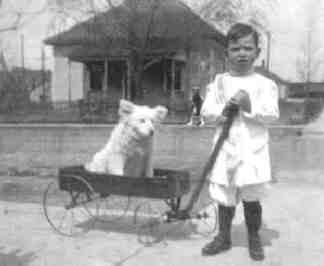
Figure 1.--This little American boy in the 1900s wears a white Russian blouse tunics, with matching knickers, and black stockings. Note the colored vertical stripe on his white tunic.

Figure 1.--This little American boy in the 1900s wears a white Russian blouse tunics, with matching knickers, and black stockings. Note the colored vertical stripe on his white tunic. |
Russian blouse tunics were a popular style for boys around the turn
of the 20th Century. Tunics had been worn by boys since early in the 19th
Century. The Russian style seems to have been particularly popular
in America at the turn of the century.
The Russian blouse style of course originated in Russia. Its origins
must have been in the 18th Century or earlier. As I have seen mid-19th
Century images of
European boys wearing Russian tunics. I do not know, however, just when
this style originated in Russia.
European boys wore Russian tunics in the mid-19th Century, possibly
before. Victoria dressed the young Prince of Whales, the future Edward VII, in
a Russian tunic, with an open square collar. A famous painting shows
the young family with the Prince in his red tunic with gold trim.
I do not know how common this style was, but think it was primarily
worn by aristocratic or wealthy children.
The Russian tunic reappeared at the turn of the Century, especially in
America. The tunics were different than those worn earlier in the
century. The turn-of-the-century tunics did not have comfortable open
square collars. Rather they were tightly buttoned at the collar like
other boys' suits in the late 19th Century. I am also not sure why this
style appeared around the turn of the century. I know it was popular in
America. I'm not sure, however, if it
also appeared in Britain and the Continent. I believe it was primarily
an American fashion--at least outside of Russia. Why it was primarily
restricted to America I can not yet explain.
The Russian blouse style tunic was a loose roomy blouse or jacket
based on the style worn by Russian peasants. The jacket would often
come below the waist giving the impression of a smock-like garment.
There were two styles of Russian blouses, an open collared style and
a closed collar style
The open collar was generally a comfortable looking open arrangement
in square pattern. Some slipped over the head and others had a few
buttons starting near a shoulder. I have called this outfit a Russian
blouse suit, although I'm not sure what it was called at the time. It is
discussed on a separate page.
Turn of the century tunics were worn with a collar that buttoned
tightly around the neck. Unlike many styles for boys at the time, there
were no stiff large collars and no
floppy bows to
be worn with it. I'm not precisely sure how they buttoned. I think they were true to the Russian style and they did not button at the back or down the front center. Instead
the buttons were offset to the right. Often contrasting trim was
added around the buttons.
Early 19th Century open-necked tunics came in a wide variety of colors,
often with contrasting trim around the square collar. Some of the
colors could be quite bright. The turn-of-the-century tunics were
generally light colors, often with contrasting trim. Often an offset
vertical strip was used as trim as well as a strip of color at the neck.
I am not sure what kind of stockings were worn with early 19th Century tunics.
Boys in the 1890s wore their Russian tunics with long stockings, usually
black or other dark colors. Some boys wore white tunics with white
stockings. After the turn of the century some boys during the summer would go barefoot
when wearing tunics, but this seemed to be more common with sailor tunics than
Russian tunics.
I am not sure what type of pants were worn with early 19th Century open necked
tunics. I believe they were worn with a variety of pants or pant-like garments, including
pantalettes, bloomer-style knickers, and long pants. There was much less
variety with turn-of-the century closed necked Russian tunics. They
were almost always worn with bloomer-style knickers, often above the knee
knickers and long stockings.
I believe that Russian tunics were worn only by boys. Girls did, however,
wear similar looking smock-like garments. They did not have the vertical
trim or the belts worn by boys with tunic outfits. The girls outfits
had knicker like pants underneath--not unlike the pants worn by boys.
They were worn with both stockings and short socks and often strap
shoes.
I know this was a popular style at the turn of the century, but have not
yet acquired much information on it. It was a style for younger boys,
probably up to about 8 years old. A small boy, however, might wear a
Russian blouse outfit for another year or two.
I have little information about what countries Russian blouses were
worn. The open collared style appears to have been primarily a European
style. I have seen images of English, French, and German boys wearing it
and it was almost certainly worn in other countries. It does not,
however appear to have been a popular style in America. This does not
seemed to have been the case for closed neck Russian tunics which were
commonly worn in America.
Not all Russian-styled garments were tunic suits. Other garments were also made with Russian style collars. The most common were
simple blouses, usually with some colored are embroidered work around the neck.
There were also short pants suits.
Boys in the 1910s and early 20s wore
simple blouses, usually with some colored are embroidered work around the neck. These were
worn much like modern "T" shirts.
The Russian-style was also worn with short pants suits, similar in part to modern jump
suits. These suits were popular in Europe during the 1900s and 10s.
Navigate the Boys' Historical Clothing Web Russian style pages: Navigate the Boys' Historical Clothing Web Site:
Closed collar
Color
Stockings
Pants

Figure 2.--The doll suggests that this child is a girl, but that is not
always a sure indicator. Another indicator that his child is a girl is the lack of belt and typical Russian tunic styling.
Gender
Age
Countries
Similar Garment
Russian short pants suits
Christopher Wagner
[Return to the Main Russian collar page]
[Return to the Main tunic page]
[Return to the Main tunic style page]
[Russian tunic]
[Russian blouse]
[Russian blouse suit]
[Introduction]
[Chronology]
[Clothing styles]
[FAQs]
[Bibliographies]
[Biographies]
[Activities]
[Countries]
[Boys' Clothing Home]
Created: April 10, 1999
Spell checked: July 22, 1999
Last updated: July 30, 1999